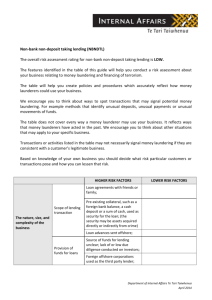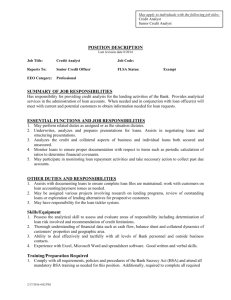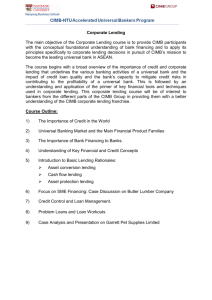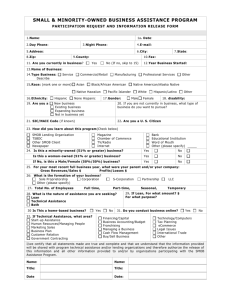Tool 5: Fair Lending Second Reviews
advertisement
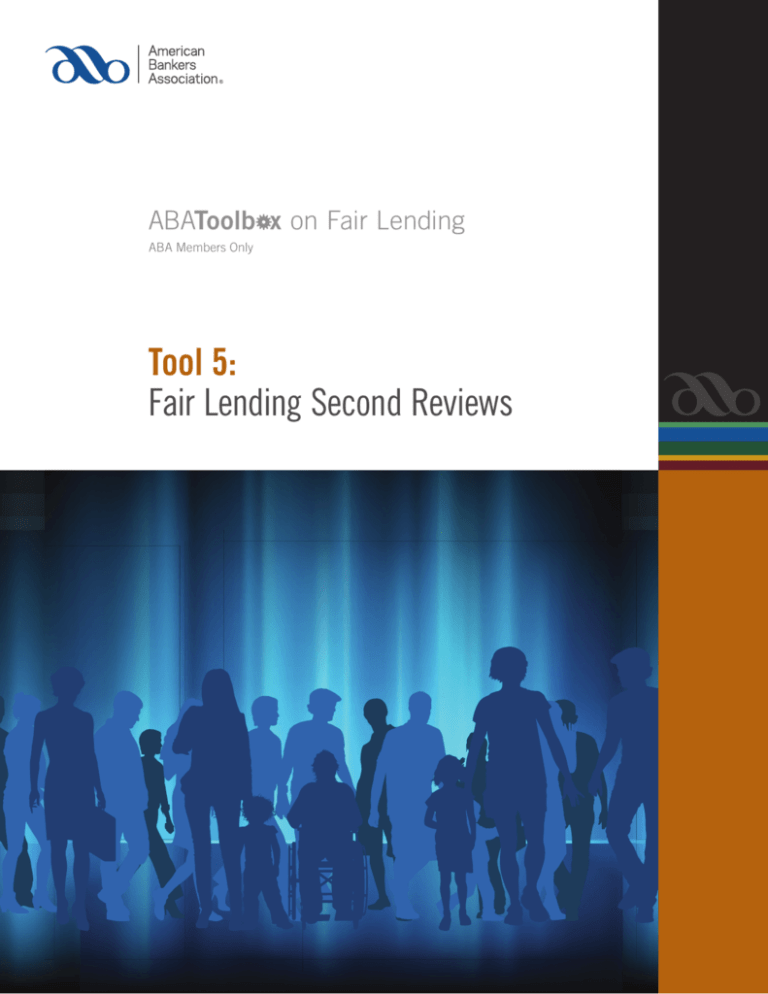
ABAToolb x on Fair Lending ABA Members Only Tool 5: Fair Lending Second Reviews About the American Bankers Association The American Bankers Association represents banks of all sizes and charters and is the voice for the nation’s $13 trillion banking industry and its two million employees. The majority of ABA’s members are banks with less than $165 million in assets. ABA’s extensive resources enhance the success of the nation’s banks and strengthen America’s economy and communities. © 2012 American Bankers Association, Washington, D.C. This publication was paid for in part with the dues of ABA member financial institutions and is intended solely for their use. Please call 1-800-BANKERS if you have any questions about this resource, ABA membership or would like to copy or license any part of this publication. This publication is designed to provide accurate information on the subject addressed. It is provided with the understanding that neither the authors, contributors nor the publisher is engaged in rendering legal, accounting, or other expert or professional services. If legal or other expert assistance is required, the services of a competent professional should be sought. This guide in no way intends or effectuates a restraint of trade or other illegal concerted action. Fair Lending Second Reviews A SMAART Approach to Second Review Programs 1 Second Review Programs—The Process 4 Step 1: Select Loans to Review 4 Step 2: Review Files6 Step 3: Document the Process6 5 Glossary Comparative File Review A comparative file review compares similarly qualified applicants or borrowers and can provide evidence that any dissimilar treatment is not related to a prohibitive basis, such as sex or race. Marginal Applicants or Borrowers Prohibited basis group and control group applicants who are neither clearly qualified nor clearly unqualified. Second Review Program A method banks can use to review denied loan applications prior to notifying an applicant by an adverse action notice. SMAART A scalable risk management framework that is applied to control and evaluate adherence to fair lending laws, regulations, internal policies or objective. A SMAART Approach to Second Review Programs A second review program is a method banks can use to review denied loan applications prior to notifying an applicant by an adverse action notice. While there is no requirement that institutions develop second review programs, they are an easily adapted process; even for very small institutions. These programs act as a preventive control to ensure all creditworthy applicants get approved for loans and that denial decisions are not based on a prohibited basis. They can result in suggested changes in underwriting standards or credit administration activities, increased institution lending volume and improving employees’ understanding of the board and senior management’s commitment to fair lending principals. Similar to comparative file reviews, second review programs are useful for all loan types including mortgage-related credit, consumer credit, smallbusiness and other commercial credit. This process can also be used in other loan account administration activities such as loan collection, loss mitigation and foreclosure and loan modification requests. To minimize the potential for fair lending risk associated with the application and other credit administration activities and to ensure that all qualified applicants are approved, institutions should consider implementing second review processes of denied applications. These reviews can do the following: • Prevent erroneous denials of loans • Identify applicants whose credit qualifications do not satisfy the lender’s underwriting standards but may qualify for a special purpose credit program • Help to ensure consistency in loan decisioning and level of assistance • Highlight areas where policies and procedures merit further clarification • Identify training opportunities for underwriters and other credit administration personnel Tool 5: Fair Lending Second Reviews | 1 From a SMAART standpoint, second review programs serve as a Monitoring control for your loan production operation and can also identify areas where Responsive process corrections can be made or where training should be fine-tuned. Implementing a second review program not only makes good business sense, but it has become a common industry practice since the banking regulators began focusing on this practice in the early 1990s. On May 27, 1993, the banking regulatory agencies issued a joint letter to the chief executive officers of financial institutions expressing the agencies’ serious concerns about lending discrimination and suggesting activities that lenders could undertake to improve fair lending performance. Two of the recommended activities pertained to second reviews: • Use an internal review system for consumer, mortgage and small business loan applications that would otherwise be denied. • Participate on multi-lender mortgage review boards that provide second reviews of applications by participating lenders. Second Review Programs are Permissible With Several Exceptions The April 1994 Interagency Policy Statement on Discrimination in Lending indicates that second review programs are permissible with several exceptions. Permissible types of second review programs might include: • Reviewing all loan applicant denials; • Reviewing all loan applicant denials within a certain income range; • Selecting a sample from all loan applicant denials; • Comparing proposed denied applicants from a prohibited basis group, such as race, with similarly qualified approved applicants from another race. For example, denied Black applicants compared to White approved applicants. • Reviewing proposed applicant denials for a specific prohibited basis if the review only tries to ensure that lending standards are applied fairly and uniformly to all such applicants. It is not permitted to review proposed denial applications for a prohibited basis group (i.e., females) in an attempt to apply creditworthiness standards that are different from the standards that were used to evaluate other applicants (i.e., males) for the same credit product. This includes using the same standards but applying them differently. 2 | ABA Toolbox on Fair Lending Benefits of Second Reviews Through a second review process, the institution has an opportunity to evaluate how the proposed credit decision was made and look for any discretion that may have been applied. When employees involved in lending activities have discretion, they generally use it and make exceptions to policy in order to grant a loan. Employees should document the exceptions they allow and the second review process should research the exceptions to decide whether policies and procedures should be updated to reflect those exceptions. A review of proposed denials or denied applications can lead the institution to ask why certain types of applications are not being approved. It may also identify needed improvements in lending training. Reviewing proposed denials has another tangible benefit. The knowledge that proposed denials will be reviewed by someone else may lead loan underwriters to consider more fully the merits of an application. Second Reviews vs. Comparative File Reviews Even when a lender adheres to written underwriting policies and procedures, a portion of applications inevitably fall into a “gray area” in which a reasonable underwriter could justify either an approval or a denial. These applications are often referred to as “marginal transactions” and are the focus of comparative file reviews. However, a comparative file review is performed after the fact; applicants have already either been approved or denied. While the marginal transaction is an efficient method in which to perform second reviews it will not necessarily get to all the issues an institution may want to evaluate. For example, looking only at the marginal applicants may not fully uncover issues related to general customer service, lending advice or assistance provided to customers and the consistency of that assistance provided. Second reviews also might identify issues related to lender compensation and how various applicants may be treated as a result. Tool 5: Fair Lending Second Reviews | 3 Second Review Programs— The Process Step 1 Select Loans to Review As a practical matter, all products should receive some sort of second review or comparative file review over time and periodically thereafter. However, a good place to start is with the fair lending risk assessment. The risk assessment conclusions should identify fair lending risk by product line, and these products and lending activities should be reviewed first. When you are considering products for second review, you can ask the following questions: • What products are manually underwritten or subject to an automated scoring system? • How much discretion do underwriters have when making loan decisions whether defined by bank policy, procedure or practice? Low Risk Products: Little Discretion If underwriters do not have any discretion in loan decisioning, the need for a second review process is limited, because discrimination risk is very low. If you perform a review of such products, it may consist only of a sample of approved and denied applications over a period of time to make sure policies are being followed and exceptions are not creeping into the underwriting process. The same may be the case with automated underwriting systems. If no exceptions are allowed discrimination risk is low. A review would focus on whether exceptions have been exercised by underwriters. If weaknesses or potential disparate treatment issues are found, you may need to increase the number of files reviewed or shift the exercise to a comparative file review. 4 | ABA Toolbox on Fair Lending High Risk Products: More Discretion When underwriter discretion is allowed, the second review program should compare files of proposed denied applications with approved applications. All of these may be marginal applicants. The proposed denied applications should be compared with applications that did not meet the institution’s underwriting policies but were approved based on compensating factors: perhaps a good customer relationship, applicant character or a deposit relationship, for example. When possible, the review should encompass all declined loans by product type. However, depending on loan volume, range of products or limited underwriting staff, it may be impractical to perform a second review on all loan denials at one time. When Should Second Reviews be Conducted? At a minimum, lenders should consider implementing second review processes for certain categories of loans, including: • Loans that were manually underwritten • Loans where the applicant’s deficient credit attribute falls within a specified threshold outside the underwriting standard (e.g., applicant has a credit score of 645 and the minimum score is 650) • Loans where certain mitigating circumstances are present (e.g., applicant can document that bankruptcy was the result of excessive medical bills) Other issues that might prompt a second review include: • An applicant requests a second review • Underwriters are allowed to exercise discretion • Underwriting standards for a particular product are not clear and subject to interpretation • File documentation standards do not exist or are not enforced • Lending staff turnover • Loan purchases from other third-party lenders Finally, you may gain valuable insight from conducting post-closing reviews of seasoned loans that were approved after second review. Tracking performance on these loan transactions can help you determine the necessity for modifications to product designs and underwriting criteria. Tool 5: Fair Lending Second Reviews | 5 Step 2 Review Files An easy way of documenting the factors you will be reviewing among all the various applicant files is to use a spreadsheet. The spreadsheet documents the second review and is similar to that of a comparative file review. It should list the lending criteria used in making the credit decision pursuant to policy, procedure or practice. It should also include the reason for denial or proposed denial and any information found in the files that indicates that policy exceptions were made, compensating factors were considered and levels of assistance offered or provided. You may wish to review other factors. Whether a lender’s second review program covers 100% of denied loans or a subset of them, it is still advisable to perform periodic comparative file reviews. See Tool 4 on Comparative File Reviews. Reviewing loans slated for denial in isolation deprives a lender of the opportunity to evaluate whether similarly situated borrowers are receiving consistent loan decisions and levels of assistance. Step 3 Document the Process Regardless of the specific purpose of the second review, every loan file reviewed should be properly documented. Denied loan files should include the factors considered in the credit decision and nondiscriminatory reasons for the denial. When denied applicant files are compared to approved applicant files, document any potential disparate treatment issues and why any apparent disparate treatment was not discriminatory. Also document any program weaknesses that may require changes to underwriting criteria, credit administraion activities, employee training or internal control systems. 6 | ABA Toolbox on Fair Lending Tool 5: Fair Lending Second Reviews | 7 1120 Connecticut Avenue, NW | Washington, DC 20036 l aba.com | 1-800-BANKERS
